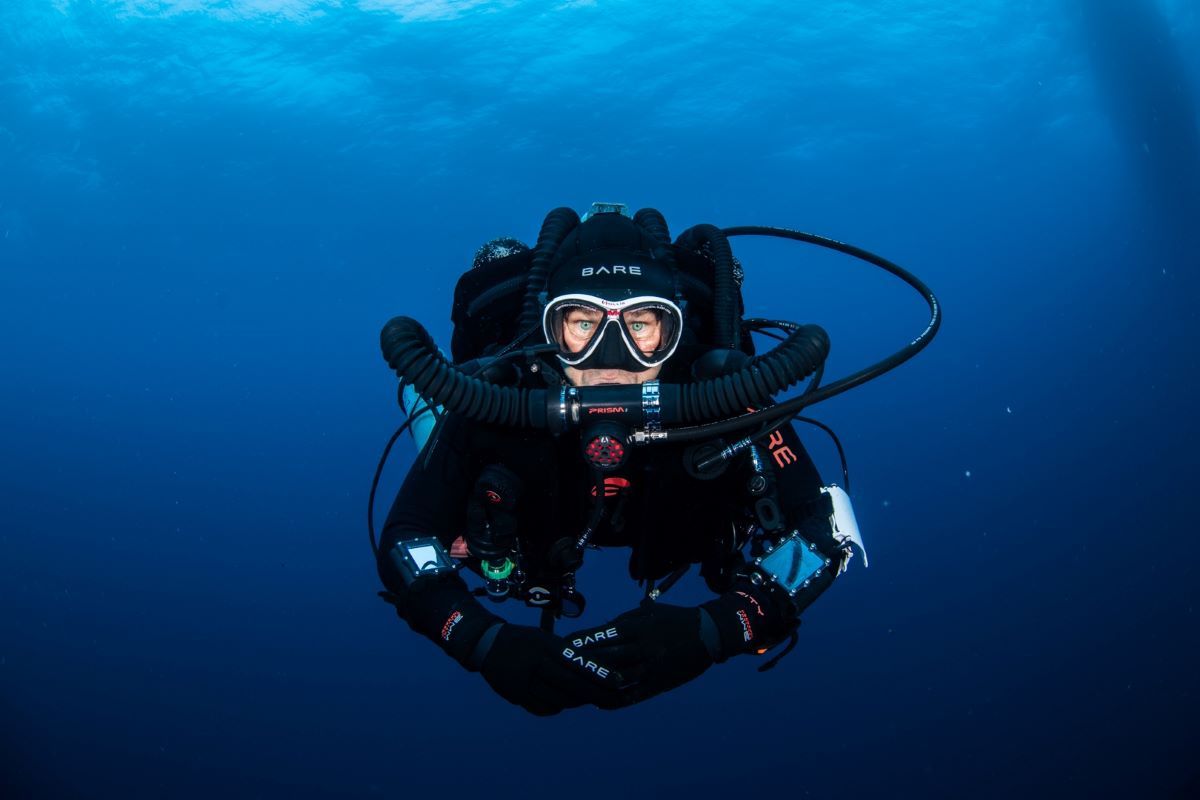
Glide through a crystal-clear underwater world, surrounded by vibrant coral reefs teeming with life. Descend deeper, further than you've ever ventured before, and the silence is broken only by the rhythmic sound of your own breathing. No bubbles rise to the surface, no fish scatter in alarm – just you and the ocean in perfect harmony. This is the captivating allure of rebreather diving, a realm of extended bottom times, deeper explorations, and unparalleled encounters with marine life.
But before you trade your trusty scuba tank for a high-tech rebreather, let's take a deep dive into the world of closed-circuit diving. We'll explore what rebreathers are, how they work, their benefits and challenges, and most importantly, whether they're the right fit for your underwater adventures.
What is a Rebreather?
Imagine a miniature spaceship strapped to your back, complete with its own life support system. That's the essence of a rebreather. Unlike traditional scuba gear, which releases your exhaled breath as bubbles, a rebreather recycles it. It scrubs out the carbon dioxide (CO2), replenishes the oxygen, and delivers a fresh, breathable mix back to you. This closed-loop system is the secret behind rebreathers' extended dive times and silent operation.
How Does It Work?
Think of it like this:
- You inhale from the rebreather's "counterlungs" – flexible bags that store the breathing gas.
- As you exhale, the gas passes through a "scrubber canister" filled with a chemical absorbent that removes CO2.
- Oxygen sensors constantly monitor the gas mix, triggering an injection of pure oxygen when needed.
- The refreshed gas returns to the counterlungs, ready for your next breath.
It's a continuous cycle, much like how a spaceship recycles air for astronauts in the vastness of space.
Types of Rebreathers
There are two main types of rebreathers:
- Closed-Circuit Rebreathers (CCR): These use pure oxygen as the breathing gas and allow for deeper dives. CCRs are more complex and require extensive training and experience.
- Semi-Closed Rebreathers (SCR): These use a mix of oxygen and a diluent gas (like air or nitrox). SCRs are simpler to operate than CCRs and can be a great stepping stone for divers interested in closed-circuit diving.
The Upside of Silent Diving
Rebreathers offer several advantages over traditional scuba gear:
- Extended dive time: By recycling your exhaled breath, rebreathers dramatically reduce gas consumption, allowing you to stay underwater longer. This is especially beneficial for exploring deeper sites or conducting underwater research.
- Deeper dives: With proper training and experience, rebreathers can open the door to depths beyond the limits of recreational scuba diving. However, it's crucial to remember that deeper dives come with increased risks and require specialized skills.
- Warmer and drier breathing gas: Rebreathers produce a warmer, moister breathing gas than traditional scuba gear, making your dives more comfortable, especially in cold water. Say goodbye to that dry mouth and chilly feeling!
- Silent operation: Rebreathers eliminate the noisy bubble stream, allowing you to see marine life in its natural state. Shy creatures like seahorses and nudibranchs won't be spooked by your approach, giving you a front-row seat to their underwater ballet.
The Challenges of Rebreather Diving
Before you jump on the rebreather bandwagon, it's essential to be aware of the challenges:
- Complexity: Rebreathers are sophisticated pieces of equipment that require specialized training and meticulous maintenance. Don't expect to master them overnight. It takes time, dedication, and ongoing practice to become a proficient rebreather diver.
- Cost: Rebreathers and the associated training are significantly more expensive than traditional scuba gear. Be prepared to invest in the equipment, courses, and ongoing maintenance to ensure your safety and enjoyment.
- Risk: Rebreather diving carries inherent risks, as any malfunction in the system can have serious consequences. Strict adherence to safety protocols, regular practice, and ongoing education are crucial for mitigating these risks.
Who's Breathing Easy with Rebreathers?
While rebreathers might seem like something out of a sci-fi movie, they're used by a variety of divers for different purposes:
- Technical divers: These intrepid explorers venture into deep wrecks, caves, and other challenging environments where extended bottom time and silent operation are essential.
- Scientific divers: Researchers and marine biologists use rebreathers to minimize their impact on delicate ecosystems and observe marine life without disturbance.
- Military/commercial divers: These professionals rely on rebreathers for stealth, extended missions, and the ability to work in challenging underwater conditions.
When to Choose a Rebreather
Rebreathers shine in specific scenarios:
- Deep dives: Beyond recreational limits, where gas consumption becomes a major limiting factor.
- Cold water dives: Warmer, moister breathing gas enhances comfort and reduces the risk of hypothermia.
- Marine life observation: Silent operation allows for closer, less intrusive encounters with underwater creatures.
Is a Rebreather in Your Future?
Before embarking on your rebreather journey, ask yourself these questions:
- Are you an experienced diver? Most training agencies require a minimum number of logged dives before you can enroll in a rebreather course.
- Are you willing to invest in specialized training? Rebreather courses are rigorous and involve ongoing practice to maintain proficiency.
- Are you prepared for the financial commitment? Rebreathers and their maintenance are considerably more expensive than traditional scuba gear.
- Are you committed to safety? Rebreather diving demands meticulous attention to detail and strict adherence to safety protocols.
Charting Your Course to Rebreather Diving
If you're ready to take the plunge, here's a roadmap:
- Do your research: Learn about different rebreather models and training agencies.
- Choose a reputable instructor: Look for an experienced instructor with a proven track record.
- Enroll in a comprehensive course: Choose a technical diving course that covers theory, practical skills, and emergency procedures.
- Practice regularly: Hone your skills in a controlled environment before venturing into open water.
- Build experience gradually: Start with shallow dives and gradually increase depth and complexity under the guidance of your instructor.
Rebreather diving is a captivating realm of underwater exploration, offering extended dive times, deeper depths, and closer encounters with marine life. However, it's not a journey to be taken lightly. It requires dedication, training, and an unwavering commitment to safety.
If you're a passionate diver seeking new challenges and a deeper connection with the underwater world, rebreathers might just be your next frontier. Remember, the journey is just as rewarding as the destination. So, embrace the learning process, dive responsibly, and let the silent world reveal its secrets to you.
Are you ready to ditch the bubbles and embrace the silence of the deep? Let Dive Right In Scuba be your trusted guide to the world of rebreathers. We'll equip you with the knowledge, gear, and support you need to transform your diving experience. Come on in – the water's fine, and the silence is even better!
